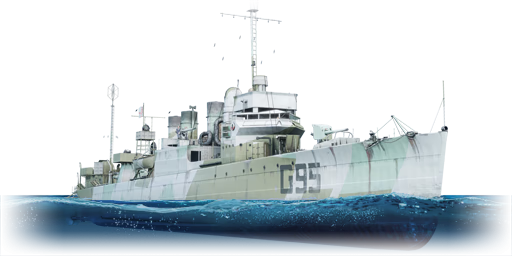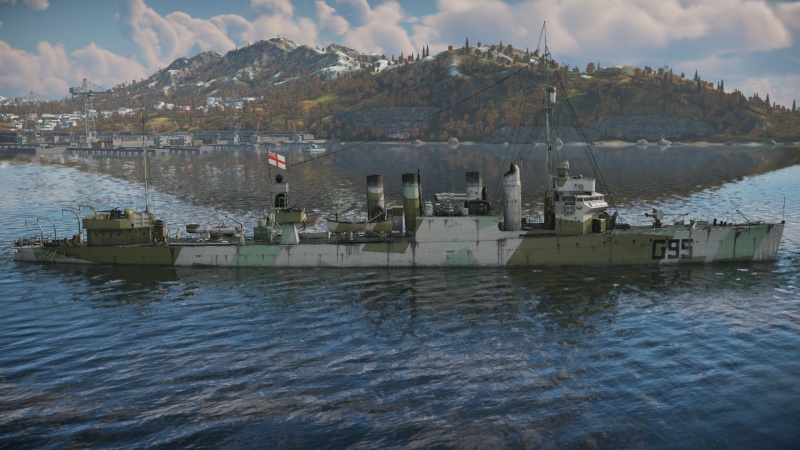Difference between revisions of "HMS Montgomery"
Bonisducks (talk | contribs) (→History) (Tag: Visual edit) |
(→Pros and cons) (Tag: Visual edit) |
||
| Line 66: | Line 66: | ||
''Summarise and briefly evaluate the vehicle in terms of its characteristics and combat effectiveness. Mark its pros and cons in the bulleted list. Try not to use more than 6 points for each of the characteristics. Avoid using categorical definitions such as "bad", "good" and the like - use substitutions with softer forms such as "inadequate" and "effective".'' | ''Summarise and briefly evaluate the vehicle in terms of its characteristics and combat effectiveness. Mark its pros and cons in the bulleted list. Try not to use more than 6 points for each of the characteristics. Avoid using categorical definitions such as "bad", "good" and the like - use substitutions with softer forms such as "inadequate" and "effective".'' | ||
| − | '''Pros:''' | + | '''Pros:''' |
| + | |||
| + | * The 3-inch gun fires more HE per minute than the 4-inch guns | ||
| + | * Has three 4-inch guns besides one from the L45 | ||
* | * | ||
'''Cons:''' | '''Cons:''' | ||
| + | |||
| + | * The two twin Browning .50 guns are pretty poor against aircraft and warships | ||
| + | * No existent AA on the G95 | ||
* | * | ||
Revision as of 12:27, 15 March 2021
| This page is about the British destroyer HMS Montgomery (G95). For other vessels of the class, see Clemson-class. |
Contents
Description
The Town-class, HMS Montgomery (G95), 1941 is a premium rank I British destroyer with a battle rating of 3.3 (AB/RB/SB). It was introduced in Update "New Power".
General info
Survivability and armour
Talk about the vehicle's armour. Note the most well-defended and most vulnerable zones, e.g. the ammo magazine. Evaluate the composition of components and assemblies responsible for movement and manoeuvrability. Evaluate the survivability of the primary and secondary armaments separately. Don't forget to mention the size of the crew, which plays an important role in fleet mechanics. Save tips on preserving survivability for the "Usage in battles" section. If necessary, use a graphical template to show the most well-protected or most vulnerable points in the armour.
Mobility
Write about the ship's mobility. Evaluate its power and manoeuvrability, rudder rerouting speed, stopping speed at full tilt, with its maximum forward and reverse speed.
| Mobility Characteristics | |||
|---|---|---|---|
| Game Mode | Upgrade Status | Maximum Speed (km/h) | |
| Forward | Reverse | ||
| AB | |||
| Upgraded | 61 | 26 | |
| RB/SB | |||
| Upgraded | 50 | 22 | |
Modifications and economy
Armament
Primary armament
Provide information about the characteristics of the primary armament. Evaluate their efficacy in battle based on their reload speed, ballistics and the capacity of their shells. Add a link to the main article about the weapon: {{main|Weapon name (calibre)}}. Broadly describe the ammunition available for the primary armament, and provide recommendations on how to use it and which ammunition to choose.
Secondary armament
Some ships are fitted with weapons of various calibres. Secondary armaments are defined as weapons chosen with the control Select secondary weapon. Evaluate the secondary armaments and give advice on how to use them. Describe the ammunition available for the secondary armament. Provide recommendations on how to use them and which ammunition to choose. Remember that any anti-air armament, even heavy calibre weapons, belong in the next section. If there is no secondary armament, remove this section.
Anti-aircraft armament
An important part of the ship's armament responsible for air defence. Anti-aircraft armament is defined by the weapon chosen with the control Select anti-aircraft weapons. Talk about the ship's anti-air cannons and machine guns, the number of guns and their positions, their effective range, and about their overall effectiveness – including against surface targets. If there are no anti-aircraft armaments, remove this section.
Additional armament
Describe the available additional armaments of the ship: depth charges, mines, torpedoes. Talk about their positions, available ammunition and launch features such as dead zones of torpedoes. If there is no additional armament, remove this section.
Usage in battles
Describe the technique of using this ship, the characteristics of her use in a team and tips on strategy. Abstain from writing an entire guide – don't try to provide a single point of view, but give the reader food for thought. Talk about the most dangerous opponents for this vehicle and provide recommendations on fighting them. If necessary, note the specifics of playing with this vehicle in various modes (AB, RB, SB).
Pros and cons
Summarise and briefly evaluate the vehicle in terms of its characteristics and combat effectiveness. Mark its pros and cons in the bulleted list. Try not to use more than 6 points for each of the characteristics. Avoid using categorical definitions such as "bad", "good" and the like - use substitutions with softer forms such as "inadequate" and "effective".
Pros:
- The 3-inch gun fires more HE per minute than the 4-inch guns
- Has three 4-inch guns besides one from the L45
Cons:
- The two twin Browning .50 guns are pretty poor against aircraft and warships
- No existent AA on the G95
History
HMS Montgomery (G95), formerly USS Wickes (DD-75), was the lead ship of the Wickes class of destroyers built for the American navy at the end of the First World War, and later transferred to the Royal Navy. Designed as the second-last American “flush-decker” destroyers (the Clemson class were the last), Wickes was built shortly before the end of the First World War and saw extensive service with the USN during the interwar years. Under the “destroyers for bases” deal, Wickes was transferred to the royal navy who renamed her Montgomery. She served during the Second World War before being finally retired and scrapped in 1945.
Design and development
The Wickes class consisted of 111 destroyers built for the United States Navy (USN) at the end of the First World War. Designed as a follow-up to the previous Caldwell class, the ships were the second class of “flush-decker” destroyers, in that their main deck was level throughout the entire ship. The following Clemson class had an even larger production run, with 156 vessels built, and would not be surpassed until the 175-ship Fletcher class was built during World War II. The lead ship of this class, USS Wickes, was laid down in June of 1917 at Bath Iron Works in Maine, and eventually commissioned in June of 1918.
Wickes displaced 1247 tons and had a crew complement of 100 officers and men. Her main armament consisted of four 4-inch (100 mm) guns in single mounts, with one at the front, two on side sponsons and one aft. She also carried two 37 mm 1-pounder anti-aircraft guns. Finally, Wickes carried twelve 21-inch (533 mm) torpedo tubes in four triple mounts, with six being able to fire to each side. Powered by geared turbines, the ship was capable of 35 knots (65 km/h).
Operational history
After her commissioning, USS Wickes began her short service of the First World War as an escort ship, escorting a convoy towards the British isles. However, her crewmembers were soon hit with the Spanish Flu, and 30 were hospitalized ashore. She later collided with an unidentified ship and took damage, and was receiving repairs when the armistice was signed to end the First World War. Wickes subsequently served as an escort ship as president Woodrow Wilson travelled to Europe to sign the surrender treaties.
After the cessation of hostilities, Wickes was sent to the Pacific through the Panama canal. Later on in 1919, she was captained by Commander William F. Halsey, who would later become one of the most famous and tactically-brilliant commanders in the Pacific war. With the decreased military expenditures of the post-war situation, Wickes was decommissioned in 1922 and laid up in reserve.
In 1930, Wickes was recommissioned, this time in the Atlantic fleet. She participated in fleet training exercises for the large part of the interwar period, including neutrality patrols after the outbreak of war in Europe. She visited numerous Caribbean ports during this time, and exercised with other American fleet units such as the battleships New York, Texas, and Arkansas.
In 1940, the British signed an agreement with the United States to exchange 50 over-age destroyers for 99-year leases on British overseas ports. Thus, the Wickes was one of the 50 ships transferred, renamed HMS Montgomery (G95). Montgomery had three of her four 100 mm guns removed, and received a heavy anti-submarine armament to make her more effective in the convoy escort role. During the war, she spent most of her time escorting convoys between the British Isles and North America. In 1944, the veteran flush-decker was retired, to be scrapped in 1945, after almost twenty years of active service.
Media
Excellent additions to the article would be video guides, screenshots from the game, and photos.
See also
Links to articles on the War Thunder Wiki that you think will be useful for the reader, for example:
- reference to the series of the ship;
- links to approximate analogues of other nations and research trees.
External links
References
- Helgason, G. (1995). USS Wickes. Retrieved January 26, 2021, from https://uboat.net/allies/warships/ship/2227.html
- Helgason, G. (1995). HMS Montgomery. Retrieved January 26, 2021, from https://uboat.net/allies/warships/ship/4299.html
| Britain destroyers | |
|---|---|
| Town-class | HMS Churchill · HMS Montgomery |
| V-class | HMS Valhalla · HMS Vega · HMS Verdun |
| G-class | HMS Grafton · ORP Garland |
| Hunt-class | HMS Calpe · HMS Brissenden |
| Tribal-class | HMCS Haida · HMS Eskimo · HMS Mohawk |
| J-class | HMS Jervis |
| K-class | HMS Kelvin |
| N-class | HMAS Nepal |
| Battle-class | HMS Armada · HMS Cadiz · HMAS Tobruk |
| Daring-class | HMS Daring · HMS Diamond · HMS Diana |
| Britain premium ships | |
|---|---|
| Motor torpedo boats | MTB-1(2) · MTB-422 · Fairmile D (5001) · HMS Gay Archer |
| Motor gun boats | MGB-75 · SGB Grey Goose |
| Gunboats | HMS Spey |
| Sub-chasers | LÉ Orla |
| Frigates | HMS Whitby |
| Destroyers | HMS Montgomery · HMS Valhalla · HMS Verdun · ORP Garland · HMS Jervis · HMCS Haida · HMS Mohawk · HMS Cadiz · HMS Diamond |
| Light cruisers | HMS Belfast |
| Battleships | HMS Iron Duke |





